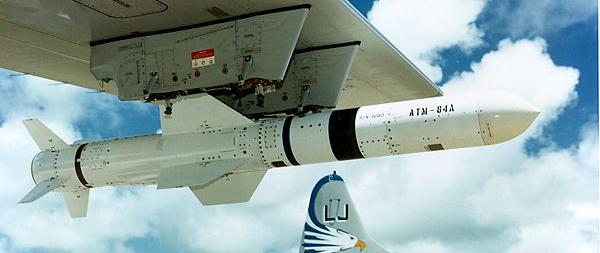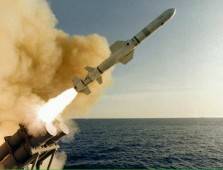We are talking about the 1980's, so it is Falklands type environment we're discussing.
An example:
http://navysite.de/weapons/harpoon.htm. You can find more trustworhy links yourself, but they all will tell the same.
Let's get some data.
"
AGM-84A, RGM-84A, UGM-84A
This was the first version of the Harpoon missile that came into service back in 1977. First to be commissioned was the shipborne RGM-84A with a range of 90km (50nm). In 1979 the AGM-84A followed suite being introduced on the venerable P-3 Orion aircraft. The last in this range of missiles was the submarine launched UGM-84A which entered service in 1981.
AGM-84C, RGM-84C, UGM-84C (Block 1B)
This versions was first introduced with the USNavy in 1982. It retained the lower cruising altitude of the B-version and added a sea-skimming flight profile, not popping up before impact. This made it more difficult to detect the missile."
http://www.f-16.net/f-16_armament_article12.html
On the weight difference
Weight Surface launched: 661.5 kg, air launched: 515.25 kg.
The figure for the surface launched variant does include the booster.
"For surface launches, RGM/UGM-84 variants use a solid-fueled rocket booster in an A/B44G-2 or -3 booster section, which is discarded after burn-out."
http://www.designation-systems.net/dusrm/m-84.html
It would be reasonable to think that the weight difference is made up by the booster giving the same range for the two missiles. The weight difference is in the ballpark. Further check out the physical appearance of the two missiles and it can be seen the difference is the booster.
So it will be reasonable to think they will have the same range when launched under the same circumstances and that if launched at altitude, the range will increase.
185 km is proposed UPGRADE for modern Harpoon.
Actually that upgrade did go ahead.
"Maximum range for surface launches is around 140 km (75 nm)."
http://www.designation-systems.net/dusrm/m-84.html
Some of the current versions have a 220 km range. But not really relevant for what we're discussing.
Moreover, the combat range for F-18 is mere 290m which is in fact smaller than combat range of P-500 missiles installed on big soviet cruisers and SSBN's.
I understand the combat radius of the F/A-18A to be similar of that of the C, which is 575 nm or 1,065 km.
http://www.vectorsite.net/avhorn_1.html#m4
As for S-3B... its a good aircraft but somewhat lack in speed.
They don't need speed. They just need to have the appropriate avionics and then carry the missile at low altitudes. They do this very well. If they fly below 200 m the Soviet surface group will never see them.
Maximum cruising speed is 426 mph or 682 km/h. This is more than adequate.
http://www.worldaircorps.com/tmpages/c2072s3r.htm
Also each of them can carry only 2 harpoon missiles
I used 2 Harpoons in my example. That's good enough.
- and if you believewhat CBG can defend itself from a salvo from single soviet SSN (20 P-500 missiles) than any soviet cruiser should have exactly zero problems defending itself from 25-30 Harpoon missiles.
The trick is that it will never come to that, as the cruiser is dead before getting into firing range.
And again, you didnt answered my point: how USA was planning to defend they supply lines from soviet crusiers and they CBG from soviet SSBN's? Dont tell me they was counting on finding them while they are more than 600km away from carrier...
The role of the USN carriers would clearly be to engage Soviet surface action groups. And to defend itself from enemy subs/air. The ASW groups will do the subhunting. Smaller soviet squadrons or single ships will be hunted down using air power from smaller carriers and land based air. They are sitting ducks.
The NATO surface groups won't engage and stay clear of powerful Soviet surface groups, they will focus on sub hunting. The Soviet surface groups are to be interdicted by carrier aviation before getting anywhere near the supply lines; who also can displace according to threat.
Also, keep in mind what missile cruisers and SSN's are much less resticted by weather conditions when aviation.
Then the CVN commander will have to look in the weather forecast and avoid getting ito such a situation. The carrier aviation makes it possible for the CVN to choose when to fight and on what terms.
I agree with you what deep in ocean soviet missile cruiser group would have less chances against USA CBG. But i pretty much doubt what SU planned such aproach against USA CBG. SSN's with P-500 was aimed as CBG "killers", and maritime aviation with SSK was aimed to keep USA CBG out of soviet home waters.
Better stay in port then, all the while NATO hunts down the SSN and SSBN.


